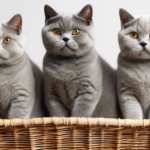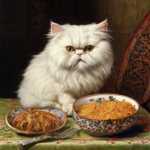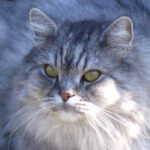## Introduction
Have you ever wondered if it’s possible for cats and rabbits to breed and create a unique hybrid creature? The idea of a cat-rabbit mix, commonly known as a cabbit, has fascinated people for years. In this article, we will delve into the world of cat-rabbit hybrids, exploring their characteristics, the controversies surrounding their existence, and the truth behind this intriguing concept.
The Fascination with Cat-Rabbit Hybrids
The concept of cat-rabbit hybrids, or cabbits, has a long history rooted in folklore, mythology, and popular culture. These mythical creatures symbolize the merging of different qualities, blurring the lines between reality and imagination. Stories of cabbits have captured our fascination, leading to speculation and curiosity about their existence in the real world.
Understanding the Genetics
To determine whether cats and rabbits can breed, we need to explore their genetic makeup. Cats belong to the Felidae family, while rabbits are part of the Lagomorpha order. These two species are genetically distinct and have evolved differently to adapt to their specific diets and environments.
Genetic incompatibility is a major factor preventing successful breeding between cats and rabbits. Cats have 38 chromosomes, while rabbits have 44 chromosomes. This difference in chromosome count makes it highly unlikely for their genetic material to align and produce viable offspring. The genetic divergence between these two species is simply too significant.
Myth vs. Reality: Debunking the Cabbit Controversy
Despite the lack of scientific evidence supporting the existence of cabbits, there have been claims and rumors of real cat-rabbit hybrids. These anecdotes often lack substantial proof and are more likely the result of misinterpretation or misidentification.
One common misconception is the belief that the physical similarities between cats and rabbits make them compatible for breeding. While both species may share certain traits, such as long ears or agility, these similarities do not indicate genetic compatibility. The distinct genetic makeup of cats and rabbits makes successful crossbreeding highly unlikely.
The Role of Imprinting and Behavior
Another factor that contributes to the myth of cat-rabbit hybrids is the phenomenon of imprinting. Imprinting occurs when an animal adopts the behavior of another species due to early exposure or nurturing. In some cases, cats have been observed nursing and raising baby rabbits. However, this behavior does not lead to the production of true hybrids. It is simply a result of imprinting and has no genetic implications.
The Importance of Diet and Digestive Systems
One significant difference between cats and rabbits lies in their dietary preferences and digestive systems. Cats are obligate carnivores, which means their bodies are adapted to a meat-based diet. On the other hand, rabbits are herbivores, relying on a plant-based diet rich in fiber.
Cats lack the necessary enzymes to digest plant material efficiently, while rabbits have specialized digestive systems that can process cellulose from plants. These fundamental differences in diet and digestion further emphasize the genetic and physiological barriers to successful breeding between cats and rabbits.
The Influence of Media and Popular Culture
The concept of cabbits has gained popularity through various forms of media, including folklore, literature, and artwork. These portrayals often romanticize the idea of cat-rabbit hybrids, captivating our imagination and blurring the line between reality and fantasy.
The prevalence of cabbits in popular culture has led to a widespread belief in their existence, despite the lack of scientific evidence. It is essential to approach these depictions with a critical eye and understand the distinction between fiction and reality.
Caring for Cats and Rabbits: Separate but Equal
While cat-rabbit hybrids may not exist, it is crucial to provide proper care for both cats and rabbits as separate species. Each species has distinct needs and requirements for diet, exercise, and living environments.
Cats require a balanced diet rich in animal protein and specific nutrients. They also need mental and physical stimulation, such as interactive play and scratching posts. On the other hand, rabbits thrive on a diet consisting mainly of hay, fresh vegetables, and a limited amount of pellets. They also require plenty of exercise and opportunities for digging and exploring.
Understanding and meeting the unique needs of cats and rabbits as separate species will ensure their health, happiness, and overall well-being.
The Future of Cabbits: Possibility or Fiction?
As technology and genetic engineering continue to advance, the possibility of creating genetically modified animals with characteristics resembling cabbits may become a reality. However, it is essential to approach these advancements ethically and responsibly, considering the welfare of the animals involved.
While the concept of cat-rabbit hybrids remains primarily fictional, the fascination with cabbits will likely persist. The mythical allure of these creatures continues to inspire art, literature, and our imagination, reminding us of the wonders of the natural world and the power of human creativity.
Conclusion
In conclusion, the idea of cat-rabbit hybrids, or cabbits, has captivated our imagination for centuries. Despite the lack of scientific evidence supporting their existence, the concept of cabbits has permeated folklore, mythology, and popular culture.
Understanding the genetic differences, behavioral traits, and dietary preferences of cats and rabbits highlights the biological barriers to successful breeding between these two species. While cabbits may only exist in our imaginations, they serve as a reminder of the enduring fascination with the unique and the unknown.
As we continue to explore the wonders of the natural world, it is important to appreciate the beauty of each species in its own right and provide proper care and respect for the animals who share our lives.





